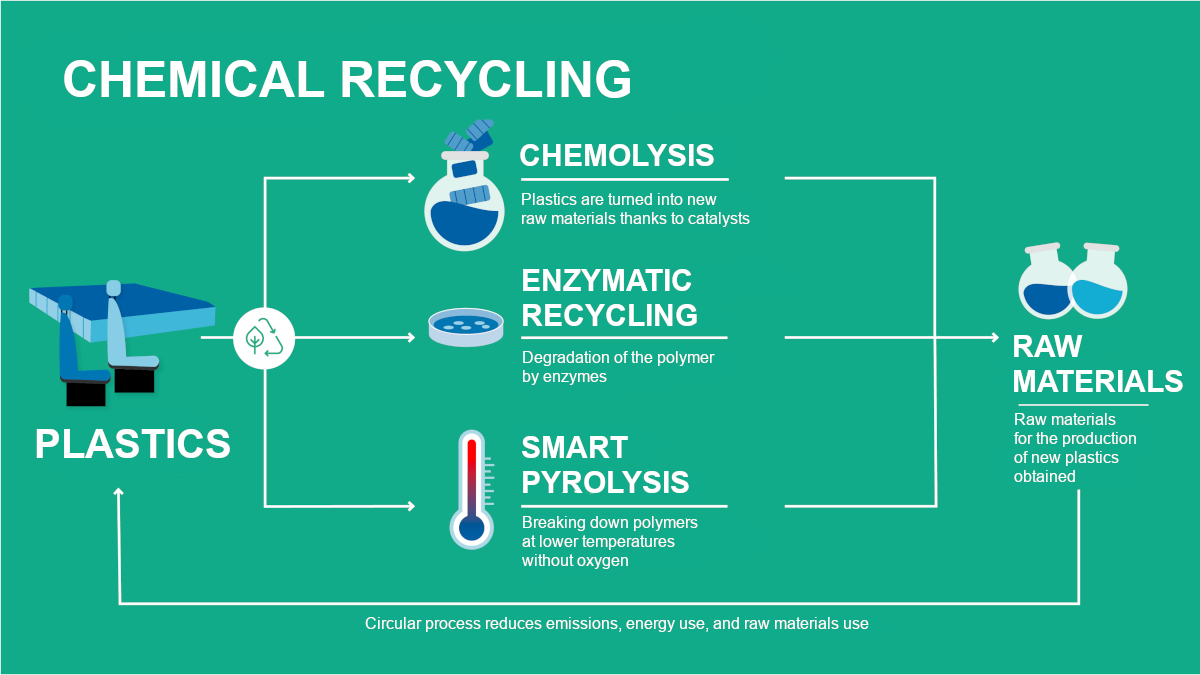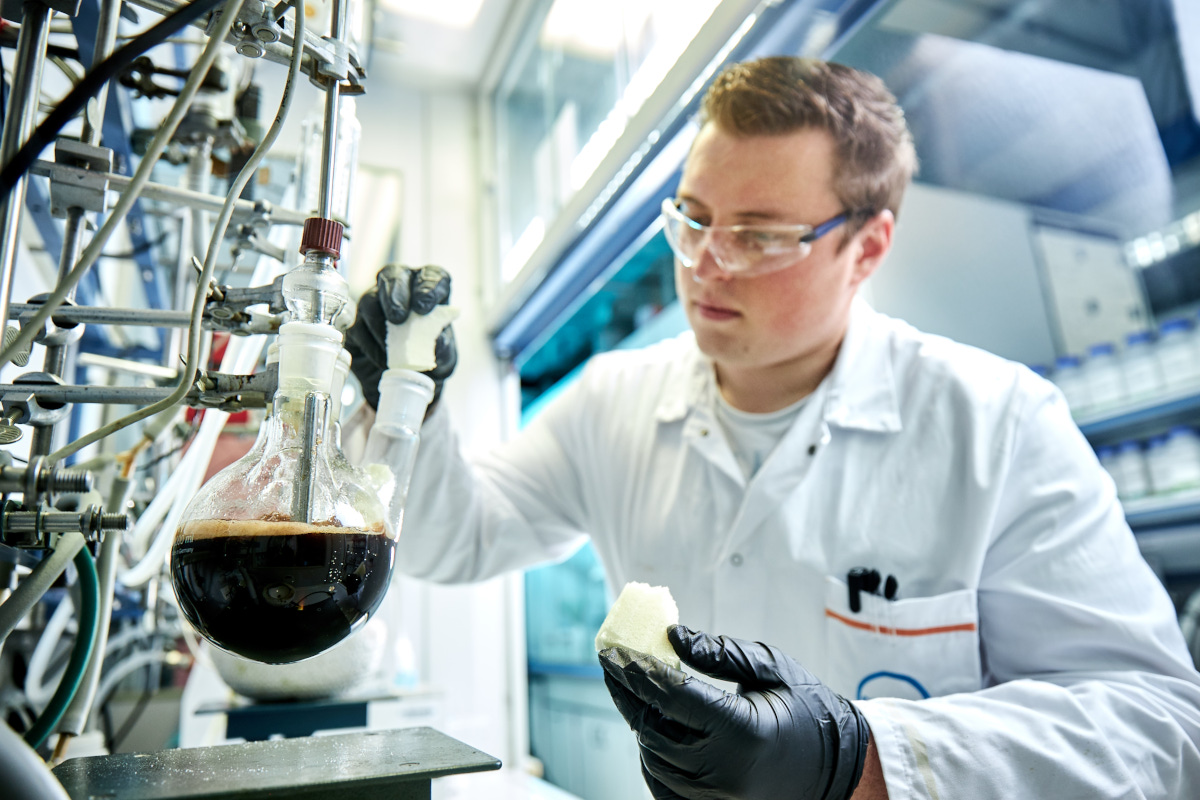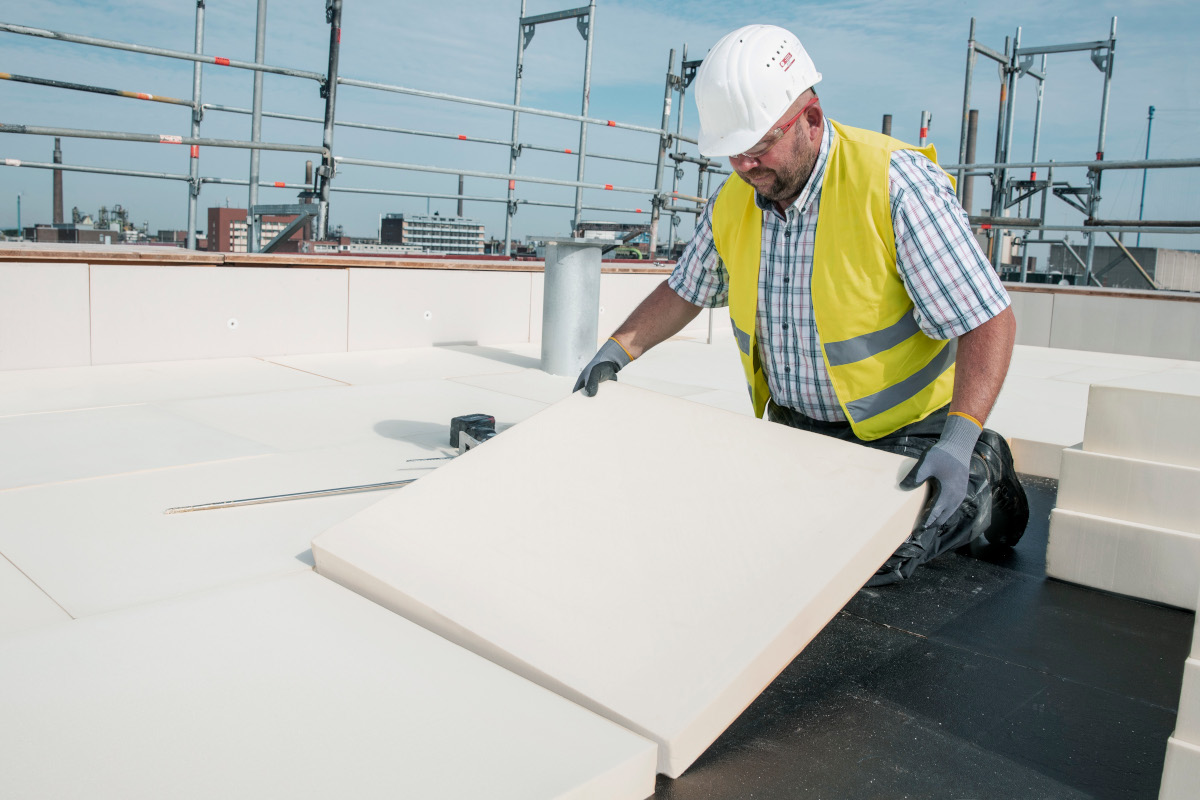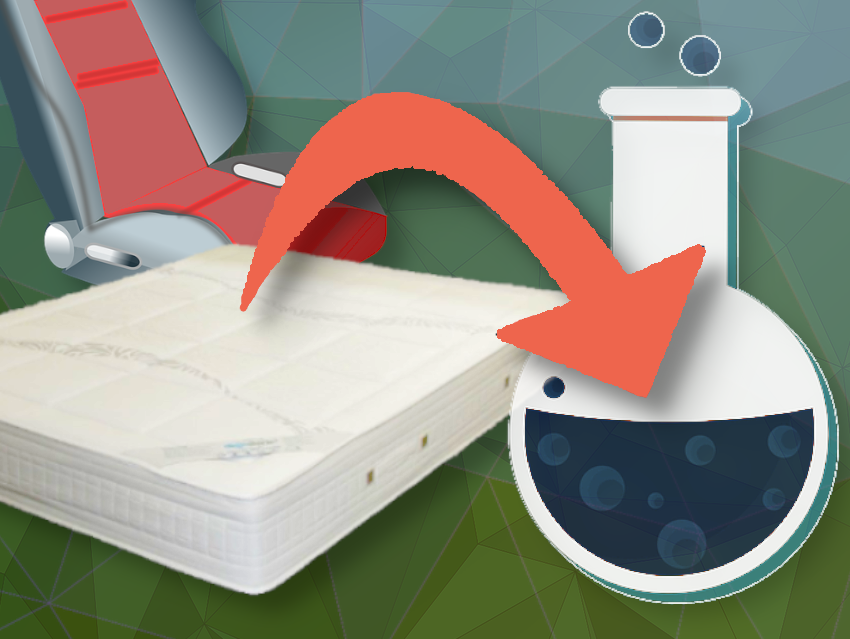The chemical recycling of plastics is gaining importance compared with mechanical recycling. Notably, chemolysis and pyrolysis have emerged as promising techniques, particularly in the efficient recycling of polyurethane (PU) foams, serving as alternatives when mechanical recycling is impossible or proves inefficient. This article explores the potential of chemical recycling to provide sustainable solutions for addressing the global waste crisis.
Climate change, ongoing environmental degradation, and limited resources for a rapidly growing world population are forcing the global community to act. We face the mammoth task of radically changing our current economy—despite the war in Ukraine, the danger of new pandemics, inflationary tendencies, a stuttering global economy, and the energy crisis.
1 Plastics—Indispensable and Well-Suited Candidates for Material Cycles
Plastics are indispensable for a climate-neutral future and for preserving resources. They are needed across all key industries—for example, for light wind turbines, thermal building insulation, the cold chain of food, in lightweight construction, and in electromobility. At the same time, they can be efficiently returned to the material cycle at the end of their useful life.
The chemical and plastics industries are key drivers of a comprehensive transformation of our economy and society towards a more climate-friendly future. For example, Europe’s chemical industry explicitly supports the EU’s Green Deal. This European Commission’s policy not only requires that member states be climate-neutral by 2050, but also promotes the transition to a circular economy.
2 Establishing Efficient Waste Management
In general, several approaches are being taken to close material and carbon cycles for plastics and to achieve climate neutrality. In addition to the increased use of alternative raw materials and renewable energies, they focus on developing and using innovative recycling technologies for plastics at the end of their useful life.
The recycling strategies require waste and recycling management of plastic products through efficient processes. To achieve this, all partners in the value chain must work closely together—from the producers of chemical raw materials to plastics manufacturers and processors to municipal waste disposal companies, sorters, and recyclables traders. The core task is to install a high-performance infrastructure for disposal and recycling on a large scale.
So far, only about 10.9 % of the plastic waste generated annually worldwide is recycled [1]. This is due, on the one hand, to the fact that around two billion people have no access to regular waste collection at all. On the other hand, not all materials are suitable for recycling with existing technologies.
3 Chemical Recycling—Focus on High-Quality Raw Materials
Plastics are currently recycled mainly by mechanical processes. In this case, plastic waste is mechanically and physically processed in various steps to produce granules (or recyclate), which can then be used as a raw material for the production of new plastic products. However, not all types of plastic can be mechanically recycled and it is not a true cycle; the quality of the recyclate degrades over time due to repeated processing. The presence of foreign materials can hinder the recycling process and affect the quality of the final recyclate.
In chemical recycling, plastics are broken down into their chemical components to manufacture entirely new products. Chemical recycling can take various forms, including (“smart” or catalytic) pyrolysis, gasification, and chemolysis (also known as solvolysis) and enzymatic recycling, each with its unique method of breaking down plastics (see also Fig. 1). Plastics manufacturers are increasingly trying to design plastics and their components to take recyclability into account directly in product and material planning.
Chemical recycling (see Fig. 1) is particularly suitable for plastic waste that cannot be mechanically recycled or can only be recycled with great effort, such as plastics used in polyurethane-based waste streams from mattresses or refrigerators.

Figure 1. In addition to mechanical recycling, chemical recycling processes such as chemolysis, catalytic pyrolysis, and enzymatic recycling are used. © Covestro
Chemolysis and pyrolysis are suitable processes for chemical recycling. In addition, enzymatic recycling at low-temperatures is currently being developed for certain plastics such as polyester. In chemolysis, polymer chains are broken down into monomers or upstream chemical raw materials by chemical reactions involving solvents, catalysts, heat, and sometimes pressure. Pyrolysis breaks down polymers into smaller chemical building blocks under inert conditions at temperatures of 500–800 °C. If catalysts are used in pyrolysis (“smart” or catalytic pyrolysis), monomers or higher-quality molecules can also be recovered.
The choice between the processes depends on the specific requirements of the process, the desired products, and environmental considerations. Chemolysis offers selectivity and controlled reactions but can be more complex. Pyrolysis, on the other hand, operates at higher temperatures, is faster, and can recover energy, but can produce a less controlled mixture of products and emissions.
What all these processes have in common is that the raw materials obtained go through purification steps and are then available for reuse. In principle, the process should be designed so that the starting monomers of the plastic can be synthesized if possible, or at least so that higher quality raw materials are produced from which they can be synthesized directly. For this reason, Covestro’s research into pyrolytic recycling of polymers focuses on the development of catalysts that make this possible.
4 Examples for Polyurethane (PU) Recycling
4.1 Closed Material Cycle for PU Mattresses
Old PU mattresses accumulate in large numbers in bulky waste and have so far been sent to landfill or incinerated. Nearly 90 % of mattresses produced in the EU contain PU foam (2–30 kg per unit). For this reason, intensive research is currently being carried out to recover these precious raw materials. Together with partners, Covestro recently achieved a technological breakthrough in the chemical recycling of foam from old PU mattresses (see Fig. 2).

Figure 2. Covestro has developed a technology for the chemical recycling of PU foams from used mattresses. © Covestro
Unlike other common plastics, PU is a polymer synthesized from polyols and isocyanates. The large variety of polyols and isocyanates allows the synthesis of many different compounds, covering a wide range of applications, but also making recycling difficult.
In contrast to established technologies on the market, the process developed as part of Covestro’s “Evocycle® CQ – Mattress” initiative allows for the recovery of both main components in polyurethane-based flexible foam applications: the polyether polyol and a precursor of the isocyanate, toluene diisocyanate (TDI). The latter is used primarily for flexible foam applications. The process is currently undergoing optimization at the Leverkusen site in a pilot plant, with plans for further scaling up on an industrial level (see Fig. 3). It now supplies high-purity polyol and 4,4′-thiodianiline (TDA). TDA is the precursor for making TDI.
The result is the production of high-purity polyol and TDA. These recycled materials can effectively substitute their fossil-based “virgin” counterparts, leading to a reduction in CO2 emissions, thus contributing to sustainability efforts. In the future, PU flexible foams from other applications—such as car seats—will also be recycled.

Figure 3. The pilot plant in Leverkusen, Germany, for the chemical recycling of flexible PU foam from mattresses is currently being optimized with a view to industrial use. © Covestro
Laboratory tests using recycled polyether polyol and recyclate-based TDIs show, that making minor adjustments to the formulations allows flexible foams to have the same mechanical properties as “virgin material.”
In addition to developing the recycling process, Covestro, in collaboration with Recticel in Brussels, Belgium, and Redwave, a division of Wolfgang Binder GmbH in Graz, Austria, has developed an intelligent sorting solution. It efficiently separates different PU types commonly used in mattresses and upholstery applications. Different PU types may have distinct properties, making it challenging to recycle them together. A software uses machine-learning algorithms for a proper recognition of the different types of foam, enabling clean material inputs for the subsequent recycling process.
4.2 Recycling PU Rigid Foam
Rigid PU foams are often used in large quantities as insulation materials to improve the energy efficiency of buildings (see Fig. 4) and refrigerators, and thus, reduce their CO2 emissions. In the future, these rigid PU foams will also be recycled to close their material loop. The “CIRCULAR FOAM” project is developing a comprehensive solution model for waste management and recycling of such foams.

Figure 4. In the future, rigid PU foams, which are often used for energy-efficient insulation in buildings and refrigerators, will also be recycled to close their material loop. © Covestro
The EU project “CIRCULAR FOAM” [2], involving a consortium of 23 industrial partners from nine countries and coordinated by Covestro, is currently working on building a fully circular value chain based on chemical recycling. The aim is to get access to end-of-life rigid foam from the post-consumer applications mentioned above and recycle it by means of chemolysis or catalytic pyrolysis. In this way, polyols and amines can be recovered. The amines are essential for making isocyanate, namely polymeric methylene diphenyl diisocyanate (pMDI).
In this way, new PU rigid foams of virgin or near drop-in quality could be produced. This could save up to 1 million tons of waste, 2.9 million tons of CO2 emissions, and 150 million euros in incineration costs every year in Europe alone starting in 2040 [3].
5 A Second Life for Paper Food Packaging—Designing Directly for Recycling
Food packaging made of paper and cardboard—such as disposable cups or fast-food boxes—accounts for a large part of the mountains of waste generated every day. Until now, such packaging has usually been coated with polyethylene (PE) or aluminum to protect the food. As a result, however, the packaging is difficult to recycle and often ends up in landfills or in thermal disposal.
A material innovation from Covestro, allows for the production of such packaging from the outset in such a way that it can be chemically or mechanically recycled. This is made possible by using a barrier coating resin, Decovery® CQ 6010 [4], which replaces the need for a PE or aluminum layer, thereby making the packaging recyclable (see Fig. 5).

Figure 5. Packaging manufactured to enable chemical or mechanical recycling, along with the inclusion of plant-based components in the barrier resin, results in a reduced carbon footprint when compared to conventional coatings made from fossil raw materials, among other benefits. © Covestro
At the same time, the barrier coating is very oil- and grease-repellent and protects the food from moisture. In addition, it consists of 37 % plant-based, traceable raw materials such as bark, castor, and corn, which reduces the CO2 footprint of the packaging compared to conventional coatings based on fossil raw materials. The resin is synthesized based on sustainable waterborne acrylic emulsion technology, which offers a uniquely high level of performance for barrier coating applications.
The example of laminated resin is representative of a new development focus in the plastics industry, namely, to design plastics and their applications in a recycling-friendly way right from the start. This so-called “chemical design for recycling” is elementary for the developing material cycles. It means, for example, that plastic assemblies are designed as mono-material solutions and are as modular as possible. As a result, they can be easily separated from one another, and the effort involved in sorting the plastics is low.
References
[1] Data Alliance – Circularity Gap Reporting Initiative, Circularity Gap Reporting Initiative (GGRi), Amsterdam, The Netherlands, 2020. (accessed August 28, 2023)
[2] Circular Foam Project (accessed August 28, 2023)
[3] Covestro’s internal calculations and assumptions.
[4] Partially bio-based resin enables recyclable food packaging, Press Release Covestro. Leverkusen, Germany, May 23, 2023. (accessed August 28, 2023)
Author
Dr. Torsten Heinemann, Head of Group Innovation & Sustainability at Covestro, Leverkusen, Germany




